Home Page :: Publications :: Property Handbook :: Section 2 :: The Home at Muirfield
MUIRFIELD PROPERTY HANDBOOK
SECTION 2: DESIGN STRATEGIES
The Home at Muirfield
 Homes
Homes at Muirfield are designed to appear to hug the ground as closely as possible. One-story homes with low profiles were built on fairways and other areas where long views are important. Two-story homes are built as part of 'interior' neighborhoods and in wooded areas to blend with the tall trees. The terrain often dictates the best-suited home for the lot. On sloping lots, split-level homes or homes with special features (like balconies, overlooking views or walk-out basements) are encouraged.
Homes
Homes at Muirfield are designed to appear to hug the ground as closely as possible. One-story homes with low profiles were built on fairways and other areas where long views are important. Two-story homes are built as part of 'interior' neighborhoods and in wooded areas to blend with the tall trees. The terrain often dictates the best-suited home for the lot. On sloping lots, split-level homes or homes with special features (like balconies, overlooking views or walk-out basements) are encouraged.
One Story homes may not exceed 20' measured from the entry level at the first floor of the home to the ridge line. In some phases, one-story homes may not exceed 22' measured from the entry level at the first floor of the home to the ridge line.
One & One-Half Story homes may not exceed 26' from the entry level at the first floor of the home to the ridge line.
Two-Story homes may not exceed 35' from the entry level at the first floor of the home to ridge line. Distance between the finish grade and entry level is to be kept in accordance with the master grading plan. Check with the City of Dublin Planning and Zoning Department.
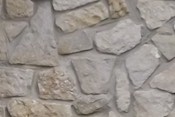 Materials and Colors:
Materials and Colors:
Natural materials such as wood, brick, stone, stucco, and tile are required on new home construction. Earth tones such as browns, tans, dusty greens, warm grays and rusty reds blend well with the trees, meadows and lakes of Muirfield Village.
The Roof and Building Mass:
Roof forms are one of the most highly visible components of a residence. Not only do they provide a vital function, but they contribute to and are integral to the overall residential design through the use of distinctive, defined styles and patterns.
The general shape of the roof, walls and appendages must fit in with the land and be compatible with neighboring homes. To be consistent with the Muirfield character, the shape and material used on the roof must be carefully chosen. In general, major roof slopes should be a minimum of 3/12 and a maximum of 12/12 pitch. The roof forms throughout the community should be compatible with one another to achieve homogeneous appeal. The roof must be consistent with the style of the residence utilizing architectural elements such as cornice treatments, roof overhangs with brackets, and richly textured materials. Multiple rooflines on varying levels on large residences will help break up the vertical mass of a residence.
Gable and hip roofs with minor variations and combinations of these two roof types are preferred. Shed roofs, when designed in a sensitive manner, are acceptable. This also applies to flat roofs when combined with gable, hip or shed roofing. Flat gambrel and mansard roofs are discouraged and are only permitted with specific approval of the MDCC.
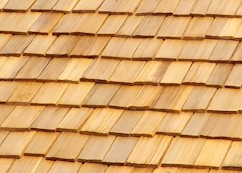 Roof material on homes abutting the Muirfield Village Golf Club, homes visible from the golf course and certain other places, are to be heavy-weight wood shakes, left to weather naturally. Roofs in other locations must be asphalt shingles, metal, slate, or tile as approved by the MDCC.
Roof material on homes abutting the Muirfield Village Golf Club, homes visible from the golf course and certain other places, are to be heavy-weight wood shakes, left to weather naturally. Roofs in other locations must be asphalt shingles, metal, slate, or tile as approved by the MDCC.
Wide overhangs are strongly encouraged. A wide overhang provides protection to the home and helps the house to appear to hug the ground. Fascia and rake boards must be stained or painted to match roofs. Gutters and downspouts are to be painted to compliment the adjacent side walls. Roof fans, jack vents and flashing, with the exception of copper, are to be painted to match the roof. Solar panels, solar tubes and sky tunnels are prohibited.
Roof patching is prohibited. All roof replacements must be approved by the MDCC. The committee reviews new materials and colors as they come on the market. The Association maintains a limited supply of colors and roofing materials for viewing at the office.
Chimney
Fireplaces are often the heart of the home. Nothing feels better than sitting by the fire on a cold or rainy day. The Muirfield home may have one or more chimneys which contain one or more flues. An exterior chimney is one with full exterior reveal and must be constructed of masonry materials to grade. Exterior cantilevered chimneys are prohibited. Exterior chimneys must be constructed of natural stone or brick.
An interior chimney is one that is built inside the home with the exterior reveal beginning at the roof of the house. The exterior portion of an interior chimney may be constructed of natural masonry materials, cultured stone or brick filets. It is prohibited use any type of wood or cedar to wrap any type of chimney.
The Four Sides of the Home:
The general shape and style of the home must fit in with the contours of the land and be compatible with neighboring homes. The architectural style should be consistent with four-sided architecture. (Four-sided architecture - the dominant material and design features at the front elevation must be incorporated on all elevations in some fashion.) The City of Dublin requires “four sided architecture” on new home construction. Architecture refers to the relationship of various features of a building including texture, proportion, entrance design, doors, windows, trim details, roofs, materials, color, mass and scale. Window detailing should emphasize and connect the four-sided nature of the home. Detailed decks, brick or stone water tables and masonry chimneys are examples of enhancements where four-sided architecture should be implemented.
A side or rear elevation may face a wooded area, pathway, golf course, or neighboring residence. The level of design along a side or rear elevation, while perhaps not as intense as the front elevation, should continue the architectural style of the residence and use the same quality materials. Architectural embellishments could include decking, awnings, and landscape materials.
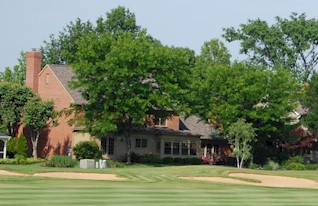 Muirfield homes incorporate wood, stone, brick and other approved materials as the dominant material on the front elevation. All-stucco homes are permitted, however, these homes must feature classic styled windows, door and corner trim detailing as well as distinctive accent features, quoining, EIFS, or other architectural enhancements.
(EIFS – Exterior Insulation Finishing System - a lightweight, synthetic wall cladding that includes foam plastic insulation and thin synthetic coatings. EIFS can add architectural interest with cornices, arches, columns, keystones, cornerstones, special moldings and decorative accents that would often be cost-prohibitive using conventional construction).
Muirfield homes incorporate wood, stone, brick and other approved materials as the dominant material on the front elevation. All-stucco homes are permitted, however, these homes must feature classic styled windows, door and corner trim detailing as well as distinctive accent features, quoining, EIFS, or other architectural enhancements.
(EIFS – Exterior Insulation Finishing System - a lightweight, synthetic wall cladding that includes foam plastic insulation and thin synthetic coatings. EIFS can add architectural interest with cornices, arches, columns, keystones, cornerstones, special moldings and decorative accents that would often be cost-prohibitive using conventional construction).
Special attention to home detailing along the pathways and golf course views is expected. The public nature of these lots require emphasis on additional detailing and landscaping as if the home has multiple front elevations. Homes adjacent to fairways must blend with golf course environment.
Homes adjacent to pedestrian pathways should be sensitive to preserve the natural setting while maintaining privacy.
Exterior Finishes and Materials:
The correct choices of residential building materials are paramount in the success of the Muirfield concept. Homes should be constructed of high quality, long-lasting materials to contribute to the stability and character intended. Important character-defining details such as brick patterns, joint spacing and color should be incorporated into the design.
Appropriate material examples include:
- Materials compatible with the area’s construction methods and styles;
- High-quality materials which result in homes -that will be as maintenance free as possible;
- Residential building materials consistent with the architectural style of the home, and;
- Building materials appropriate to the scale of the home.
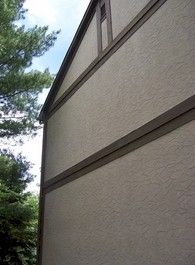 The
following are durable materials recommended for use:
The
following are durable materials recommended for use:
- Cedar siding - recommended are 4" to 8" clapboard, rough or smooth finish; channel rustic boards; v-joint tongue-and-groove boards; vertical board and batten; or wood shingles; all with solid color stains.
- Brick - color ranges should be subtle. Speckled or glazed effects are prohibited. Brick details in chimneys, window sills, entry steps and foundations are encouraged.
- Stone - native Ohio limestone in gray or buff laid horizontally is acceptable. Rubble and roughly squared stone may be used. Square-cut dimensional or ashlar stone is not encouraged. If a flat-faced, vertical bed stone is used, flush joints rubbed with burlap are recommended. Use of artificial stone products, such as “brick filets”, “cultured stone”, “stucco stone” or other manufactured materials, are prohibited on new construction. Artificial stone is only considered on an interior chimney in which the exterior reveal is from the roof line upward. The MDCC may consider artificial stone on remodeling of existing structures where there is no existing brick ledge.
- Composite siding materials (cement board siding products, such as “Cemplank”, “Hardi-Plank”, or other manufactured materials) will be considered for exterior remodeling projects.
- Stucco, Dryvit, EIFS Systems - natural, subtle sand finish texture, hand troweled or hit-skip texture is preferred; swirls, scratches, splashes, and artificial textures are discouraged. Colors must blend with natural earth colors such as sand, subtle buffs, and tans. White is not permitted.
Inappropriate materials include:
- Exterior walls designed and/or constructed of materials with a limited life expectancy
- Materials incompatible with the architectural style of the residence
- Poorly crafted or “rustic” woodworking and finishing techniques
- Vinyl, aluminum or T-1-11 siding
- Mill-finish aluminum extrusions for windows and doorways
- Unfinished cinder block walls
Use of Color:
The roof and side wall materials of each home shall be compatible with each other and must blend into a common color tone. Natural colors of natural materials blend easily together. When man-made materials are used, colors must blend with natural materials. Accent colors are permitted only on shutters and front entry doors as approved by the MDCC.
 The color palette of a home is composed of the colors of the main body of the home, trim, and accent colors. The colors chosen for awnings, shutters and roofs also contribute to the overall color scheme of the home. The overall color scheme must reflect a cohesive appearance.
The color palette of a home is composed of the colors of the main body of the home, trim, and accent colors. The colors chosen for awnings, shutters and roofs also contribute to the overall color scheme of the home. The overall color scheme must reflect a cohesive appearance.
These guidelines recognize that the review of a home’s color scheme is a balance between the owner’s creativity and individuality, the architectural style of the building, and an overall harmonious vision for the neighborhood. A two or three-color scheme is encouraged to provide visual appeal. The main body color is the predominant color of the home. The trim color is applied to architectural elements such as windows, doors, columns, porches, decks, etc. The trim color must be complimentary to the main body color. In a three-color scheme, the accent color can be used sparingly to highlight certain architectural elements, such as a front door and shutters.
Inappropriate use of color includes:
- Colors that are garish, gaudy, loud, excessive and ostentatious
- Colors that constitute a glaring and unattractive contrast to surrounding natural environment or homes
- More than three different colors or color shades used on a single home unless appropriate to the architectural style of the home
- The use of fluorescent or day glow colors
- Color used to obscure important architectural features
Doors:
Doors are a vital element providing not only visual but also physical connections between the private space within the home and the street. A welcoming entry is more important than any other exterior part of the home. In most cases, the front door shall be raised-panel wood or fiberglass. There are limited areas in Muirfield Village where a flush exterior door may be considered. All exterior doors changes must be submitted to the MDCC for review.
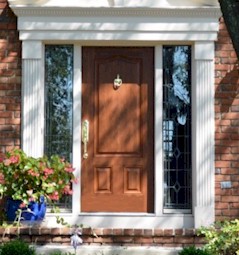 To enhance the walkway to the home, care should be taken to select aesthetically pleasing arrangements and natural materials, such as wood, brick, stone or pavers. An inviting walkway connects strongly with the front entrance making it easy to use the front door and can add to your home’s landscape. It is ideal that it be part of the entry garden, partially enclosing it with plantings.
To enhance the walkway to the home, care should be taken to select aesthetically pleasing arrangements and natural materials, such as wood, brick, stone or pavers. An inviting walkway connects strongly with the front entrance making it easy to use the front door and can add to your home’s landscape. It is ideal that it be part of the entry garden, partially enclosing it with plantings.
Storm Doors, Sliding Glass Doors, Rear Entry, Side Entry and Screen Doors:
Certain full-view storm doors may be considered. The color of the storm door must be the trim color of the house or the color of the entry door. Decorative "scalloped" storm door panels and unpainted aluminium doors are prohibited.
 Garage Doors
Garage Doors
The MDCC will consider raised panel wood, fiberglass and certain heavy-gauge insulated steel doors as acceptable replacements. In specific areas of Muirfield and on specific architectural home styles, flush doors will be considered for approval. The garage door is generally a more discreet feature of the home and, as a general rule, the finish on the garage door will be the trim color of the house or stained a natural wood color. When contemplating replacing garage doors, consider the architectural style of the home and the neighborhood as there are many styles available, however, not all styles of garage doors will be complementary or appropriate for the home.
Windows and Exterior Doors
Windows and doors are vital elements that link the inside and outside of your home. From the outside, it’s important that they’re appropriately-sized for your home’s particular style, creating a consistent and cohesive architectural pattern.
In the early days of Muirfield Village, very few options were available for windows and exterior doors; most of the originals were wood, and many of those have been, or are ready for, replacement. Today, changing technology in window and door design and construction offers many options for new and replacement units. Some of those are appropriate for installation in Muirfield Village homes, and some are not. Generally, the Muirfield Association will only approve applications for new or replacement windows and doors that are very similar in appearance to original wood units.
It is important to check with the Association office early in the planning stage for assistance with any type of window installation or replacement, since all new and replacement windows and doors must be approved by the Muirfield Design Control Committee (MDCC) before installation can begin. Please review the information below before choosing windows and doors for your Muirfield Village home.
Window and Door Construction
There are five types of window/door construction that are often seen on applications in Muirfield Village:
- All-Wood – these are often seen on higher-end homes. All wood windows and doors can be painted or stained on both the exterior and interior, offering the homeowner a wide variety of choices in color, and allowing easy color changes down the road. All-wood is almost always approved by the MDCC.
- Wood/Clad – these are solid wood construction, with an exterior “cladding” that protects the exterior from damage by the elements. This exterior cladding is usually aluminum, fiberglass, or vinyl. The structural strength of the wood core allows these windows and doors to closely replicate the design of traditional wood windows. These windows and doors have limited color choices on the exterior, but the interior side can be painted or stained per the owner’s taste. Wood/Clad windows and doors are frequently approved by the MDCC.
- Composite – these are built of a material made from a mixture of wood fibers and polymers (plastic). Because they are constructed entirely of this composite, they offer the advantage of very low maintenance inside and out. Their structural strength also allows these windows and doors to closely replicate the design of traditional wood windows. Fiberglass offers limited colors choices on the exterior and interior, and in limited circumstances, can be painted. Composite construction is often approved by the MDCC.
- All-Fiberglass – Because they are constructed entirely of fiberglass, these windows and doors offer the advantage of very low maintenance inside and out. The structural strength of fiberglass also allows them to closely replicate the design of traditional wood windows and doors. Fiberglass offers limited color choices on the exterior and interior, and in limited circumstances, can be painted. Fiberglass windows and doors are often approved by the MDCC.
- All-Vinyl - these are built entirely of PVC, offering the advantage of very low maintenance inside and out. Vinyl fames are hollow, with additional material added to increase the strength of the vinyl. This additional material sometimes results in larger frames and sashes that do not closely replicate the design of traditional wood windows. All-vinyl offers limited color choices on the exterior and interior, and in limited circumstances, can be painted. All-vinyl windows and doors are sometimes approved by the MDCC, depending on the color and exterior profile.
While the Muirfield Association’s jurisdiction only applies to changes on the exterior of Muirfield Village homes, we strongly recommend that you carefully consider the materials on the interior of your new windows and doors, too. While low-maintenance is an important consideration for the exterior of your windows and doors, it is not a factor on the interior. More important to your home’s long-term value is the ability for a new owner to change the interior window color to match their decorating taste, and to match the interior trim colors. This is more or less difficult depending on the window/door construction type you choose.
Window and Door Installation
The proper installation of new and replacement windows and doors is important for the longevity of the unit and for the integrity of the wall, but also for the exterior appearance of the window/door, exterior trim (if any), and exterior cladding. For new construction, this usually means installing the window first, then the exterior trim, and finally, the siding, stucco, brick, or stone cladding.
In replacement applications, the Muirfield Association will only approve installations where the entire window unit, often including the interior and exterior trim, is removed and replaced. This “full frame” replacement method is required in order to assure that replacement window installations are indistinguishable from new window installations. Full-frame replacement may not be an option with all window and door construction types. It is the homeowner’s responsibility to ensure that their window/door supplier and installer are complying with all of the requirements of the Muirfield Association.
Muirfield Village Window and Exterior Door Standards for Review
The Muirfield Association Design Control Committee will review applications for new and replacement windows, per the information above, the Muirfield Village Design Standards, and the following guidelines:
1. Window Size/Shape/ Style
- New/replacement windows should replicate the profile of traditional wood windows as closely as possible
- Window styles should be appropriate for the style of the home (i.e. double-hung windows on Colonial homes, casements on Tudor homes, etc.)
- Window styles should generally not be mixed on a house. Exceptions include fixed windows with operable windows, awning windows with casements, etc.
- Window size/shape should be appropriately proportional to the house and to other windows on the house
- Sash width should be appropriate for the window style, and should not be wider than a new traditional wood window, or larger than the window sashes being replaced
- Window “grids” should be installed where architecturally appropriate. “SDL” or “TDL” grids are preferred to between-the-glass or snap-in grids
- Exterior cladding is acceptable, but the “sharp-edged” look found in extruded cladding is preferred rather than the “soft-edged” look of roll-formed aluminum cladding
- Single hung windows are prohibited
- Decorative glass may be considered in specific areas, but may not detract from the unified exterior appearance of the home
2. New Window Installation
- New window frames and sashes should be properly located within the wall relative to the exterior finish:
■ Masonry finish – window frame, sash, and brick mould must sit behind the face of the masonry
■ Siding/Trim – on installations with perimeter trim, window frame should be flush or behind trim.
■ Window sashes that protrude beyond the face of the window frame, or the exterior trim, will not be approved
■ Siding/No Trim – brick mould may be used with siding only when no other trim material is used
■ Stucco installations (same as siding installations above)
3. Replacement Window Installation
- Replacement windows must meet all the “new window” requirements above, and:
■ Replacement windows should be appropriate to the style of the home, even if previous replacement windows were not
■ Replacement window installations should be “full frame” rather than sash only – this means that the entire window unit must be removed prior to the installation of new windows
■ Exterior trim should be removed and reinstalled/replaced
■ No additional “build out” material or “wrap” may be used on the exterior of a replacement window installation
4. General
- Applications for new windows, or window replacements, must include detailed technical information about the windows. In some cases, an actual window sample may be required
- New/replacement windows should be of the highest quality design and construction
- No windows are “pre-approved”; all window installations require review by the Muirfield DCC
- Other requirements of the Muirfield Design Standards apply (color, etc.)
- Other requirements of the City of Dublin Zoning and Building regulations may apply
Awnings
Awnings can be approved to make decks, patios or windows more usable in the summer where homes have little or no shade protection. The MDCC will consider the following in the review of awning applications:
- Awnings must be of cloth construction. Metal (other than the supporting frame), fiberglass or other awning materials are prohibited
- Awnings may only be used on the rear of a home
- No more than one awning may be used on a home
- Awnings must be designed as in integral part of the overall home design
- Awnings with lateral or retractable support arms are preferred over vertical post supports. Lateral arm style supports tend to have more head clearance and usable space. Soffit-mounted or wall-mounted supports are preferred
- Roof mounting is prohibited
- Awnings must be properly proportioned to fit the area they cover
- Awnings may only be of earth-toned solid colors or small-patterned fabrics that complement the house
- Decorative edges such as scallops, fringe, or tassels are prohibited
Canopies and Umbrellas are temporary, seasonal structures placed on decks or patios to provide shade. Canopy and umbrella tops must be cloth material. Metal, fiberglass and aluminum tops are prohibited; the support poles and framework may be metal or wood. Canopies and umbrellas may not be permanently affixes to the house in any way. They must be neutral, earth-toned colors. Logos or advertising of any kind is prohibited on any portion of the canopy or umbrella. Canopies and umbrellas may be placed on a deck or patio from April 1st until October 31st. After that date, the canopy or umbrella must be removed from the deck or patio and stored inside.
Egress windows
Egress windows are emergency exits, and are required by building codes in all bedrooms and on all floors of a house. When you finish existing basement space in your home, especially if that space is to be a bedroom, you’ll likely have to add egress windows. In many cases, those new windows will require window wells to meet codes.
In all cases, the installation of egress windows and/or window wells must be approved by the MDCC. The following will be considered in egress window and window well applications:
- Egress windows must be designed to be as unobtrusive as possible
- Egress windows must match the other windows in the house
- Window wills may not be installed on sides of the home facing the street. On other sides, where possible, window wells should not be visible from the street
- Window wells may be constructed of concrete block, wooden timbers, or some types of prefabricated units, depending on the construction of the home and the location of the window well
- Depending on the location, the MDCC may require landscaping to screen a window well
Shutters
Shutters may be used as architectural accents on some styles of homes, especially homes with a strong traditional character. Shutters should be made to appear as authentic as possible. The MDCC will consider the following in reviewing shutter applications:
- The architectural style of the home
- The size of the shutters – generally, a pair of shutters should be wide enough to cover the entire window if they were closed over the window
- Materials – shutters should be of solid wood or composite construction; some vinyl shutters may not be approvable
- Color – shutters may be an accent color, but the color must be a part of an overall approved color scheme for the house
- Location – when possible, shutters must be on all windows on any one elevation of a house
- Hardware – authentic shutter hardware is preferred
Window Boxes
Window boxes will be considered on a case-by-case basis. Window boxes must be architecturally appropriate to the home. Care must be taken to select durable, insect-resistant and moisture-resistant materials.
Skylights
Skylights can be entirely appropriate when they complement the overall design of the house. Applications for skylights will be reviewed on a case-by-case basis with the following considerations:
- Skylights on the rear and sides of a house will generally be viewed more favorably than skylights on the front of a house
- Skylights may be fixed or operable
- Skylights must have flat glass glazing. Dome type and plastic glazing is not permitted.
- Skylights may not sit on raised curbs
- Solar panels, solar tubes, and sky tunnels are prohibited
- Skylight frame colors must match the roof shingle color
Other Architectural Features
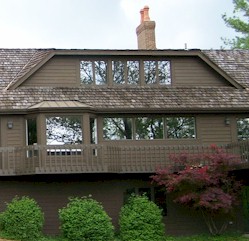 Other architectural details and elements (balconies, overhangs, decks, patios, seat walls, railings, etc.) must be appropriate to the style and function of the home and architecturally integrated with the design of the home. The same amount of thought and care should be put into the selection and installation of these architectural features, including use of door handles and hinges, mail slots, egress windows, shutters, awnings, lighting, address numbers and other elements.
Other architectural details and elements (balconies, overhangs, decks, patios, seat walls, railings, etc.) must be appropriate to the style and function of the home and architecturally integrated with the design of the home. The same amount of thought and care should be put into the selection and installation of these architectural features, including use of door handles and hinges, mail slots, egress windows, shutters, awnings, lighting, address numbers and other elements.
Compost Bins
Compost Bins can be used to redirect food scraps into nutrients for gardens. Composting involves mixing yard and household organic waste in a bin and providing conditions that encourage decomposition. The decomposition process is fueled by millions of microscopic organisms (bacteria and fungi) that take up residence inside the compost pile, devouring and recycling it to produce a rich organic fertilizer and valuable soil amendment. The MDCC will review requests for composting bins, taking into consideration the location, size and type of composting receptacle. The receptacle should be located at the rear of the property, in an inconspicuous area and camouflaged with evergreen materials or opaque fencing for year-round screening while still allowing full access to the unit. When selecting a site, consider how odor and sight nuisances could affect your neighbors. Noncompliance with the sight and odor requirements may result in the bin being permanently removed.
Rain Barrels
Rain Barrels can provide a way for residents to 'go green' and be cost efficient. Rain water can be collected by attaching roof downspouts to an approved receptacle. After a heavy rain, water collected in these receptacles can be used to water gardens and yards. Using a rain barrel is a source of free soft water containing no chlorine, lime or calcium, making it ideal for gardens, flower pots or car and window washing. Screening may be necessary, depending on the location, dimension and appearance.
The MDCC will review requests for rain collection receptacles. The receptacles must be located at the rear of the home in an inconspicuous area and camouflaged with evergreen materials for year-round screening while still allowing full access to the unit. The color of the rain barrel should be considered so that it blends in with the surroundings. Plastic units are subject to fading and cracking due to weather and temperature fluctuations.
Detached Structures
Certain types of detached buildings are acceptable at Muirfield when they are designed to integrate with the design of the home; this means utilizing identical materials, colors and overall design characteristics of the home. These structures must be incorporated within the buildable area of the property. Structures such as sheds, privacy walls, fences, outdoor kitchens, fire pits, gazebos, pergolas, trellises, decks and patios must be consistent with the design of the main structure. They should be screened with landscaping to guarantee privacy. Metal storage sheds and other pre-fabricated outbuildings are prohibited.
